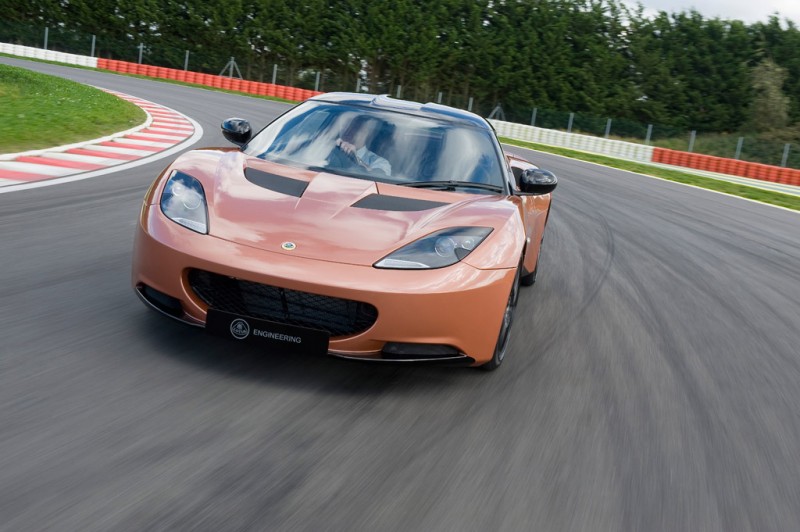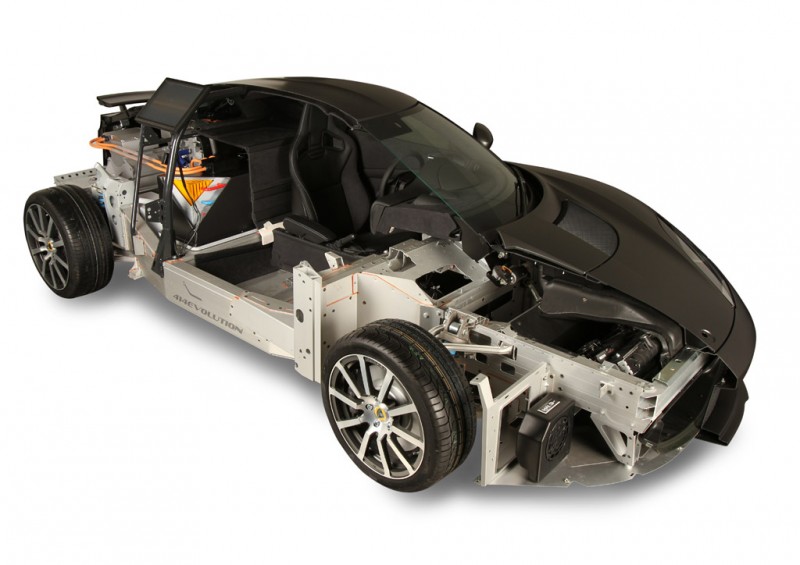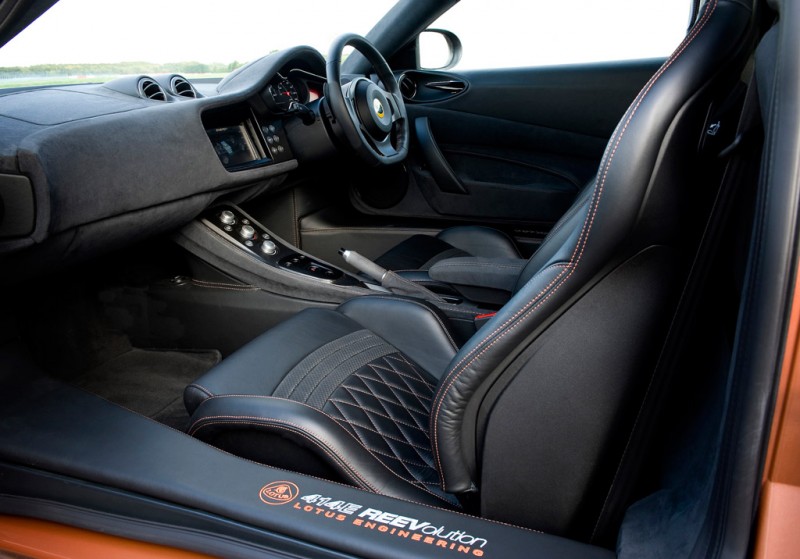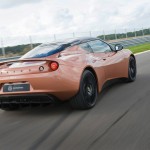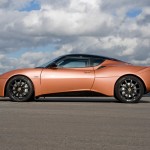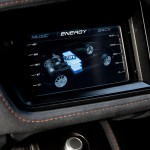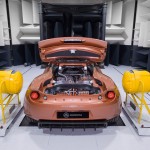The Lotus Evora 414E Hybrid has been developed as technology demonstrator from Lotus Engineering, producing 414 PS (305 kW) of power and promises breathtaking performance from a highly efficient propulsion system. The concept showcases new developments in plug-in range extended electric propulsion and new electronic technologies to enhance driver involvement. Not only have Lotus been busying themselves with creating this advanced plug-in hybrid, but they have also recently been awarded £10.44 million by The Regional Growth Fund (RGF), which will be used for research and development of products, along with staff training. This new funding is expected to add over 300 jobs at the firms Norfolk home.
The range extended electric drive of the Evora 414E Hybrid consists of two electric motors driving each of the rear wheels independently via a single speed geartrain, integrated into a common transmission housing, thus enabling torque vectoring for stability control of the vehicle. Electrical power is stored in a lithium polymer battery pack which is optimised for energy density, efficiency and high power demand and mounted in the centre of the vehicle for stability and safety.
Additional range is provided by the Lotus Range Extender engine, an optimised 1.2 litre, three cylinder engine, designed specifically for series hybrid vehicles. The drivetrain is designed to combine astonishing performance with efficient, low emissions driving.
Driver involvement is enhanced by the incorporation of HALOsonic Internal and External Electronic Sound Synthesis technologies from Lotus and HARMAN, which provide sound contouring within the cabin and improve pedestrian safety outside the vehicle. Integrated with the HALOsonic technology, the Evora 414E Hybrid also showcases a brand new technology from Lotus Engineering, a sports mode that simulates a 7 speed, paddle shift transmission that combines exceptional driver involvement for a hybrid sports car and optimised energy recuperation.
The Evora 414E Hybrid has been designed to highlight Lotus’ innovative electric and hybrid vehicle technology without distracting from the pure sportscar character of the Evora.
The Drivetrain
For the Lotus Evora 414E Hybrid, Lotus Engineering has developed a highly efficient, high performance drivetrain system consisting of twin motors supplied by EVO Electric Limited, each limited to providing 152 kW (207 PS / 204 hp) of power and 400 Nm (295 lbft) of torque to each wheel via independent, single speed, reduction transmissions integrated into a single housing, enabling torque vectoring dynamic control of the vehicle.
The vehicle energy storage system is made up of the latest Lithium Polymer battery chemistry providing 15 kWH energy storage capacity. The battery pack is optimised for energy density, efficiency and high power demand, with over 300 kW discharge capability.
The Range Extender engine provides 35 kW of power at 3,500 rpm via the integrated electrical generator. The engine uses an optimised two-valve, port-fuel injection combustion system to reduce cost and mass and can be operated on alcohol-based fuels and/or gasoline. The generator converts mechanical energy to electrical energy to replenish the battery pack charge and provides additional vehicle range in a small light weight package. The generator is also used as a motor to start the range extender engine. The low mass of the whole range extender unit (85 kg) and compact package makes it ideal for the series hybrid drivetrain in the Evora 414E Hybird.
The operation of the range extender engine, including the power management of the batteries and motor are managed by Lotus’ electronic control units and software systems. Full energy management of all the operating systems is the key to maximising performance and operation while minimising energy consumption and CO2 emissions.
For everyday commuting journeys, up to 35 miles can be travelled using battery power. The battery can be charged overnight using a conventional domestic mains supply through a socket concealed by the rear number plate. This permits the vehicle to operate with zero tailpipe emissions. For longer journeys, exceeding the battery capacity, the highly efficient range extender engine is used as a generator to supply the motor with electrical power and top up the battery.
Driving Dynamics and Torque Vectoring
The Lotus Evora 414E Hybrid offers exhilarating, all-round dynamic performance and takes advantage of Lotus developed torque vectoring dynamics. Torque vectoring, which is the capacity to generate different torques at each of the driving wheels, is particularly suited to electric vehicles.
A key benefit of separate motors to drive each rear wheel individually is that this facilitates a much higher level of vehicle dynamics control. Driving the wheels with different levels of torque can not only generate all the capabilities of a conventional ESP system using energy regeneration as opposed to brake application, but it can also actively drive each wheel forward at different rates, producing a turning moment at the rear of the vehicle in addition to the steering input.
This can be used to enhance low speed manoeuvrability and ease of parking but can also be used to produce a much greater level of straight line high speed stability. Incorporating lateral sensors the system also provides stability control capabilities and levels of steering response normally only associated with heavy and expensive rear steer systems. This can provide automatic correction of both under-steer and over-steer characteristics. In addition, the standard method to provide high speed stability of designing the rear wheels to toe-in is not required as the torque vectoring system automatically provides this stability control, with toe-in increasing rolling resistance, lowering fuel economy and increasing tyre wear. Lotus‘ long history of active suspension control provides the core capability to develop this technology and provides extraordinary driving pleasure on the Evora 414E Hybrid.
Driver Interaction
The Evora 414E Hybrid provides less of a psychological step change for people familiar with high performance cars compared to other electric and hybrid sports cars. The car has a simulated paddle shift gear change offering ultra quick gear changes reminiscent of a dual clutch transmission, while actually being a single speed. This enhances the driver interaction with the vehicle and provides a driving experience similar to current internal combustion engine high performance sports cars. The Evora 414E Hybrid uses a column mounted paddle shift to simulate the gear change and a synthesised engine sound changes frequency with virtual gear selection. The drive torque is also modulated to simulate a physical feeling of sporty gear shift.
The virtual gear shift simulation, like a conventional gearbox, is used to change the driving characteristics and response of the vehicle. The most significant aspect that this offers the driver is the ability to control the vehicle deceleration by simulating engine braking through a virtual down-shift in gears. Unlike true engine braking, the Lotus system does not dissipate the energy of the moving vehicle through internal engine friction but uses the electric motors to regenerate the energy back into the battery. While many electric and hybrid vehicles provide engine braking, this is generally at a fixed rate or preselected rate. In some driving situations this can either be too aggressive, slowing the vehicle unnecessarily, or too light, requiring additional braking application. The Lotus system effectively allows the driver to select the appropriate level of regeneration by simulating stepping down by one, two or even three gears. The simulation of engine braking through both the gear noise change and the retardation of the vehicle is fully intuitive to a driver familiar with a conventional gearbox. The simulated gear change capability can be selected for greater driving involvement or switched off for more relaxed driving.
The Evora 414E Hybrid uses the Lotus Engineering and HARMAN developed HALOsonic suite of noise solutions. The first of which is Electronic Sound Synthesis. This generates engine sounds inside the vehicle through the audio system where it provides an exciting sports sound in line with the brand and nature of the vehicle together with a high level of driver feedback in an intuitive manner. In addition, it also generates sound on the outside of the vehicle through speakers mounted at the front and rear to provide a warning to increase pedestrian safety, which is especially important for electric and hybrid vehicles which can be difficult to hear at slower speeds.
There are four driver selectable engine sounds currently on the vehicle, two of which have been designed to have characteristics of a multi-cylinder conventional V6 and V12 engine. There is also a futuristic sound and a combination of a conventional engine and a futuristic sound, enhancing the brand identity of the vehicle as a step forward in electric vehicle design.
The addition of this Lotus patented simulated gear shift concept not only provides for an exciting and involving driving experience that customers would expect from a Lotus, but also enhances the driver’s control of the vehicle while providing the capability for more efficient operation through a greater use of energy regeneration.
HALOsonic: Sound Technology with Vision
This cutting-edge enhanced version of the HALOsonic safety system incorporates input from imaging sensors to enhance the quality of the sound synthesis system. HALOsonic has been developed specifically for electric vehicles and hybrid electric vehicles.
The system on this latest version of HALOsonic, a collaboration between HARMAN and Lotus, uses a single camera to determine the distance, trajectory and speed of pedestrians and other road users, calculating the risk of collision by comparing this information with the car’s path. The new HALOsonic system uses this data to actively control the volume of the External Sound Synthesis to warn pedestrians of the vehicle’s location, thereby improving pedestrian safety and reducing noise pollution. Under certain conditions the system will generate an audible and visual warning for the driver using the Internal Sound Synthesis and instrument panel.
The new active system is optimised to operate in urban environments where there is the greatest risk of a collision with a pedestrian. It is calibrated to actively control the volume and pitch of the sound synthesised while the vehicle is travelling from 0 – 75 km/h, continually evaluating the risk of a pedestrian collision and operating in an area up to 60 metres ahead of the vehicle. All of the HALOsonic systems are designed to use low levels of power and with the new active version there will be less power consumed as the system will only increase the volume when there is a risk of an impact.
This innovative new active safety system is integrated into the HALOsonic range of products, which includes: External Sound Synthesis, Internal Sound Synthesis, Road Noise Cancellation and Engine Order Cancellation. The HALOsonic range has been designed by Lotus Engineering and HARMAN and offers a production ready technology as a stand-alone or integrated ICE system solution.
Source; Lotus
